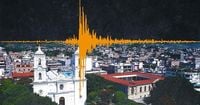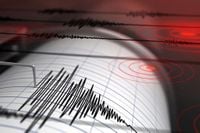On March 28, 2025, a magnitude 4.0 earthquake struck near Miahuatlán, Oaxaca, at 5:27 AM Central Time (11:27 UTC), according to the Servicio Sismológico Nacional (SSN). The earthquake's epicenter was located 61 kilometers northeast of the city of Oaxaca, with a depth of 69.6 kilometers. This seismic event is part of a larger pattern of tectonic activity in Mexico, a country known for its susceptibility to earthquakes due to its position on the Pacific Ring of Fire.
The Centro Nacional de Prevención de Desastres (Cenapred) advises the public to refrain from spreading rumors and to rely on official sources for information following seismic activity. Residents are encouraged to conduct safety checks in their homes for any potential damage. In case of an earthquake, individuals should use their cell phones only for emergencies, avoid lighting matches or candles until they are certain there are no gas leaks, and remain vigilant for possible aftershocks.
In preparation for earthquakes, Cenapred recommends that individuals create a civil protection plan, organize evacuation drills, identify safety zones in homes and workplaces, and prepare emergency backpacks. During an earthquake, it is crucial to stay calm and seek shelter in a safe location, away from falling objects. If in a vehicle, drivers should stop and move away from buildings, trees, and utility poles. Those near the coast should evacuate to higher ground to avoid tsunamis.
Mexico has a long history of significant seismic events. The strongest recorded earthquake in the nation occurred on March 28, 1787, with a magnitude of 8.6 in Oaxaca, resulting in a tsunami that penetrated 6 kilometers inland. More recent earthquakes, such as the devastating 8.2 magnitude quake on September 19, 1985, and the 2017 earthquake, which caused 369 fatalities, have left a lasting impact on the nation.
The 1985 earthquake, which struck at 7:19 AM local time, was particularly catastrophic, leading to widespread destruction in Mexico City. The 2017 earthquake occurred 32 years later, at 1:14 PM, with its epicenter located between the states of Puebla and Morelos. Both events serve as reminders of the potential for seismic disasters in the region.
In addition to the quake near Miahuatlán, two other significant seismic events were reported on the same day. A magnitude 4.2 earthquake occurred 63 kilometers southeast of Sayula de Alemán, Veracruz, at a depth of 143 kilometers. Another tremor, measured at 4.4 magnitude, struck 30 kilometers east of CD Lazaro Cárdenas, Michoacán, with a depth of 60.4 kilometers. These occurrences illustrate the ongoing seismic activity in the region.
Experts from the United States Geological Survey (USGS) have highlighted that nearly 75% of the U.S. territory could experience damaging earthquakes in the future, particularly along the West Coast, which is near the Pacific Ring of Fire. This region is known for its high seismic and volcanic activity, making it one of the most earthquake-prone areas globally.
In light of this, the USGS points out that significant cities like San José, Vallejo, and San Diego in California are particularly vulnerable due to their geological fault lines. In fact, the strongest recorded earthquake in history occurred on May 22, 1960, in Valdivia, Chile, with a magnitude of 9.5. This catastrophic event triggered volcanic eruptions and a tsunami, resulting in over 2,000 fatalities and affecting two million people.
Understanding the causes of earthquakes is essential for preparedness. Earthquakes result from the sudden release of energy within the Earth's crust, primarily due to the movement of tectonic plates. This movement can cause immense friction, leading to the generation of seismic waves that travel through the rock and to the surface.
Terminology can sometimes confuse the public when discussing seismic events. The term “sismo” refers to any movement of the Earth's crust, regardless of its intensity, while “temblor” is used for minor movements that do not cause damage. A “terremoto,” however, is a more severe earthquake that can result in significant destruction and loss of life.
In light of the recent seismic events, authorities continue to stress the importance of preparedness and awareness. The public is urged to stay informed about earthquake safety measures and to remain vigilant in the face of ongoing seismic activity.





